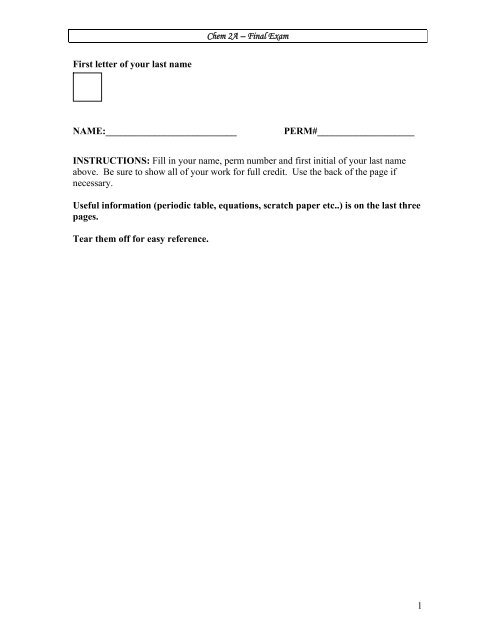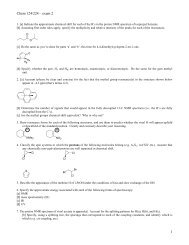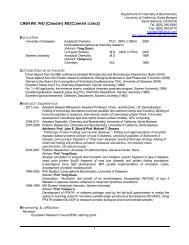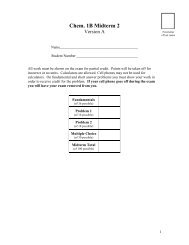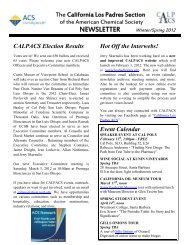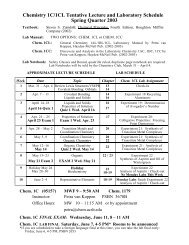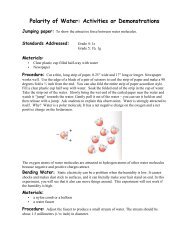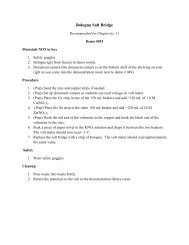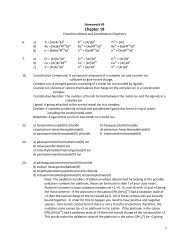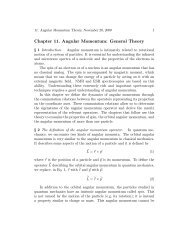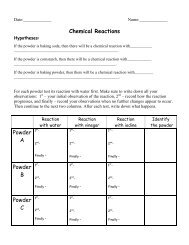Chem 2A – Final Exam First letter of your last name NAME: PERM ...
Chem 2A – Final Exam First letter of your last name NAME: PERM ...
Chem 2A – Final Exam First letter of your last name NAME: PERM ...
- No tags were found...
Create successful ePaper yourself
Turn your PDF publications into a flip-book with our unique Google optimized e-Paper software.
<strong>Chem</strong> <strong>2A</strong> <strong>–</strong> <strong>Final</strong> <strong>Exam</strong><strong>First</strong> <strong>letter</strong> <strong>of</strong> <strong>your</strong> <strong>last</strong> <strong>name</strong><strong>NAME</strong>:___________________________<strong>PERM</strong>#____________________INSTRUCTIONS: Fill in <strong>your</strong> <strong>name</strong>, perm number and first initial <strong>of</strong> <strong>your</strong> <strong>last</strong> <strong>name</strong>above. Be sure to show all <strong>of</strong> <strong>your</strong> work for full credit. Use the back <strong>of</strong> the page ifnecessary.Useful information (periodic table, equations, scratch paper etc..) is on the <strong>last</strong> threepages.Tear them <strong>of</strong>f for easy reference.1
<strong>Chem</strong> <strong>2A</strong> <strong>–</strong> <strong>Final</strong> <strong>Exam</strong>SCORE: ________ 100 pts possiblePART I <strong>–</strong> SHORT RESPONSE / MULTIPLE CHOICE1. (2 pts) Consider the following reaction: <strong>2A</strong> + B ⎯⎯→ 3C + DIf 3.0 mol <strong>of</strong> A and 2.0 mol <strong>of</strong> B react to form 4.0 mol <strong>of</strong> C. What is the percent yield<strong>of</strong> the reaction?a) 50%b) 67%c) 75%d) 89%e) 100%f) none <strong>of</strong> the above2. (2 pts) What volume <strong>of</strong> 18.0 M sulfuric acid is required to prepare 16.5 L <strong>of</strong> 0.126 MH 2 SO 4 ?a) 11.6 mLb) 0.116 Lc) 232 mLd) 0.264 Le) 1.16 Lf) none <strong>of</strong> the above3. (2 pts) For which acid solution below does 50.0 mL neutralize 50.0 mL <strong>of</strong> a 0.2 MBa(OH) 2 solution?a) 0.1 M HClb) 0.2 M HNO 3c) 0.3 M HBrd) 0.1 M H 2 SO 3e) 0.2 M H 2 SO 4f) none <strong>of</strong> the above2
<strong>Chem</strong> <strong>2A</strong> <strong>–</strong> <strong>Final</strong> <strong>Exam</strong>4. (3 pts) What is the oxidation state <strong>of</strong> chromium in K 2 Cr 2 O 7 ?a) +2b) +3c) +6d) -2e) -3f) none <strong>of</strong> the above5. (3 pts) According to the equation: 2 KClO3( s) ⎯⎯→ 2 KCl( s) + 3 O2( g)3.00 grams <strong>of</strong> KClO 3 (122.55 g mol -1 ) decompose and the oxygen at 24.0 o C and0.982 atm is collected. What volume <strong>of</strong> oxygen gas will be collected, assuming 100%yield?a) 304 mLb) 456 mLc) 608 mLd) 911 mLe) 1820 mLf) none <strong>of</strong> the above6. (3 pts) 0.05 moles <strong>of</strong> NaF are dissolved in water to prepare 250 mL <strong>of</strong> solution. If noother substance is added to the solution which <strong>of</strong> the following statements is true.a) [H + ] = [OH - ]b) [H + ] = [F - ]c) [Na + ] = [H + ]d) [HF] = [OH - ]e) [OH - ] = [F - ]f) none <strong>of</strong> the above3
<strong>Chem</strong> <strong>2A</strong> <strong>–</strong> <strong>Final</strong> <strong>Exam</strong>7. (5 pts) Write the molecular formulas for the following compoundsa) manganese (II) hydroxide _________________________b) potassium hydrogen carbonate _________________________c) sodium sulfate _________________________d) ammonium phosphate _________________________e) Ferrous nitrate _________________________8. (5 pts) What is the pH <strong>of</strong> a 0.2 M solution <strong>of</strong> sodium acetate, NaC 2 H 3 O 2 ?(for acetic acid - K a = 1.8 × 10 -5 )a) 2.72b) 4.98c) 9.02d) 5.44e) 8.56f) none <strong>of</strong> the above9. (8 pts) Calculate the concentration <strong>of</strong> Cu 2+ in a pH = 8.50 buffer solution that has beensaturated with Cu(OH) 22+ -Cu(OH) ( s) Cu ( aq ) + 2 OH ( aq ) K sp = 1.6 × 10 -19a) 1.6 × 10 -2 Mb) 1.8 × 10 -7 Mc) 1.6 × 10 -8 Md) 3.2 × 10 -6 Me) 5.7 × 10 -10 Mf) none <strong>of</strong> the above24
<strong>Chem</strong> <strong>2A</strong> <strong>–</strong> <strong>Final</strong> <strong>Exam</strong>15. (8 pts) Calculate the pH <strong>of</strong> a solution that is prepared by adding 19.3 grams <strong>of</strong> sodiumnitrite (NaNO 2 ) to 500 mL <strong>of</strong> 0.1 M nitrous acid (HNO 2 , K a = 4.5 × 10 -4 ). Assumethere is no change in volume <strong>of</strong> solution.16. (7 pts) The sulfide ore <strong>of</strong> zinc (ZnS) is reduced to elemental zinc by “roasting” it inair to give ZnO followed by heating with carbon monoxide. The two reactionsinvolved are below.3ZnS + O2⎯⎯→ ZnO + SO22ZnO + CO ⎯⎯→ Zn + COIf 5.32 kg <strong>of</strong> ZnS are treated in this manner and 3.30 kg <strong>of</strong> pure Zn is obtainedcalculate the percentage yield for this process.28
<strong>Chem</strong> <strong>2A</strong> <strong>–</strong> <strong>Final</strong> <strong>Exam</strong>17. (13 pts) Consider the titration <strong>of</strong> 50 mL <strong>of</strong> 0.2 M carbonic acid (H 2 CO 3 ) with 0.5 MNaOH. The titration curve is shown below. K a values are found in the table at the end <strong>of</strong>the exam.a) Label the first and second equivalence points A and B respectively on the plot above.b) Calculate the pH <strong>of</strong> the solution at the first and second equivalence points.c) Calculate the pH <strong>of</strong> the solution when 35.0 mL <strong>of</strong> NaOH have been added to thesolution.9
<strong>Chem</strong> <strong>2A</strong> <strong>–</strong> <strong>Final</strong> <strong>Exam</strong>Equations101,325 Pa = 1 atm760 torr = 1 atmN0= 6.02214×1023−27amu = 1.66054×10 kgPVnTPV=nT1 1 2 21 1 2 2PV= nRTR = 0.08206 L⋅atm⋅mol ⋅KR = 8.314 J ⋅mol ⋅K-1 -1-1 -1Kw = K Kab2⎛ n ⎞⎜P+ a ( V − nb)= nRT2 ⎟⎝ V ⎠nRT nP= −aV − nb V22K = [ H O ][ OH ] = 1.0×10w3+ − −14pH =−log[ H O+ ][ HA]pH = pKa− log [ ]3A −10
<strong>Chem</strong> <strong>2A</strong> <strong>–</strong> <strong>Final</strong> <strong>Exam</strong>Acid Dissociation Constants (25 o C)Name Formula K a1 K a2 K a3Acetic HC 2 H 3 O 2 1.8 × 10 -5Ammonium ion+NH 4 5.6 × 10 -10Arsenic H 3 AsO 4 5.6 × 10 -3 1.0 × 10 -7 3.9 × 10 -1<strong>2A</strong>scorbic HC 6 H 7 O 6 8.0 × 10 -5 1.6 × 10 -12Benzoic HC 7 H 5 O 2 6.5 × 10 -5Boric H 3 BO 3 5.8 × 10 -10Carbonic H 2 CO 3 4.3 × 10 -7 4.8 × 10 -11Chloroacetic HC 2 H 2 O 2 Cl 1.4 × 10 -3Citric H 3 C 6 H 5 O 7 7.4 × 10 -4 1.7 × 10 -5 4.1 × 10 -7Hydroazoic HN 3 1.9 × 10 -5Hydrocyanic HCN 4.9 × 10 -10Hydr<strong>of</strong>luoric HF 7.2 × 10 -4Hydrogen selenate ion-HSeO 4 2.2 × 10 -2Hydrogen sulfide H 2 S 9.1 × 10 -8 1.1 × 10 -12Hypobromous HBrO 2.1 × 10 -9Hypochlorous HClO 3.0 × 10 -8Hypoiodous HIO 2.3 × 10 -11Iodic HIO 3 1.7 × 10 -1Lactic HC 3 H 5 O 3 1.4 × 10 -4Malonic H 2 C 3 H 2 O 4 1.5 × 10 -3 2.0 × 10 -6Nitrous HNO 2 4.5 × 10 -4Oxalic H 2 C 2 O 4 5.9 × 10 -2 6.4 × 10 -5Phenol HC 6 H 5 O 1.3 × 10 -10Phosphoric H 3 PO 4 7.5 × 10 -3 6.2 × 10 -8 4.2 × 10 -13Propionic HC 3 H 5 O 2 1.3 × 10 -5Pyrophosphoric H 4 P 2 O 7 3.0 × 10 -2 4.4 × 10 -3Selenous H 2 SeO 3 2.3 × 10 -3 5.3 × 10 -9Sulfuric H 2 SO 4 Strong Acid 1.2 × 10 -2Sulfurous H 2 SO 3 1.7 × 10 -2 6.4 × 10 -8Tartaric H 2 C 4 H 4 O 6 1.0 × 10 -3 4.6 × 10 -5Base Dissociation Constants (25 o C)Name Formula K bAmmonia NH 3 1.8 × 10 -5Aniline C 6 H 5 NH 2 4.3 × 10 -10Dimethlyamine (CH 3 ) 2 NH 5.4 × 10 -4Ethylamine C 2 H 5 NH 2 6.4 × 10 -4Hydrazine H 2 NNH 2 1.3 × 10 -6Hydroxylamine HONH 2 1.1 × 10 -8Methylamine CH 3 NH 2 4.4 × 10 -4Pyridine C 5 H 5 N 1.7 × 10 -9Trimethylamine (CH 3 )CN 6.4 × 10 -5 11
<strong>Chem</strong> <strong>2A</strong> <strong>–</strong> <strong>Final</strong> <strong>Exam</strong>Scratch Paper….12


